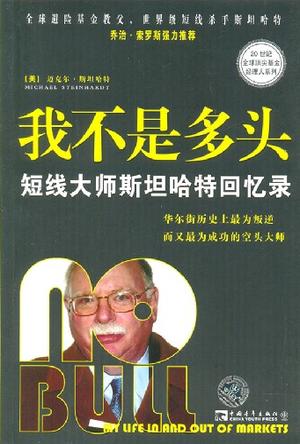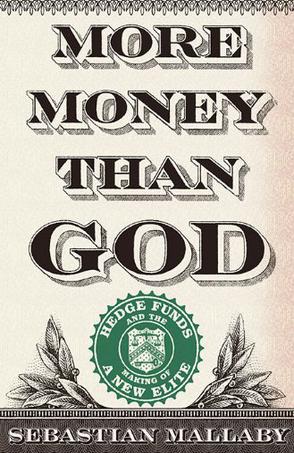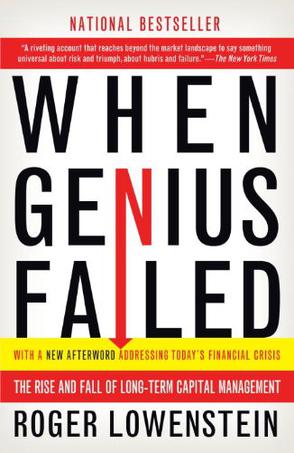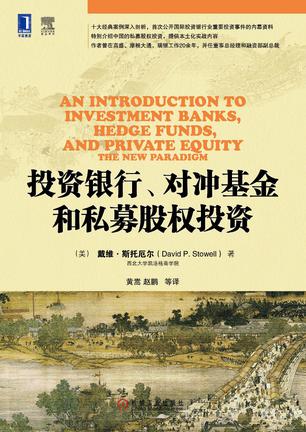-

从800万到200亿
丹尼尔·A.斯特奇曼引人入胜地追寻着朱利安·罗伯森从北卡罗莱纳州到华尔街的足迹,探究了他的个性化的世界和使他成为那个时代投资界的一段传奇的交易策略和投资风格。 在《从800万到200亿》中你将会看到罗伯森如何运用他的决断能力、财务技巧和远见卓识让只管理着800万美元基金的老虎基金管理公司发展壮大成一个管理着超过200亿美元资产的基金混合体,成为全世界最成功的对冲基金组织之一的掌舵者;了解到罗伯森在股票、固定收益证券、商品市场里发现机会并执行交易的才能;发现他怎样在一个令人难以置信的动荡的市场里坚守期铜和约的仓位,并最终从中获得巨额利润。同时,你还会看到他的一些决策失误和市场不正常波动导致其黯然关闭公司的过程,从中得到更多的启发。 当你通过《从800万到200亿》了解了这位有着传奇色彩的基金经理在发展对冲基金和使之得到普及所发挥的作用的同时,你还会知道老虎基金管理公司的文化如何培养了另外一批成功的被称做“小老虎”的基金管理人,这些基金管理人继续在随后的很多年里影响着资产管理这个行业的管理和运作。尽管如此,没有一个基金管理人能够像罗伯森那样在资产管理领域具有如此广泛深入的影响。 -

我不是多头
在20世纪的华尔街正史中,应该毋庸置疑地为迈克尔•斯坦哈特留出几页。作为华尔街历史上最成功的基金经理人之一,斯坦哈特以30%的年均收益率而出类拔萃——这是远远高于任何一个市场标杆的。在他长达30年的对冲基金经理人生涯当中,他为他的投资人和他自己积累了巨额财富。如果在他的旗舰对冲基金斯坦哈特合伙人基金(Steinhardt Partners LP)成立时的1967年投入1万美元的话,到1995年他从基金管理工作中抽身出来时,它的价值就已经是481万美元了。 《我不是多头》记录了帮助对冲基金经理人迈克尔•斯坦哈特取得历史性成功的投资策略,包括他作为行业分析师和完美的选股专家使用的一些技巧。他还介绍了他知晓何时应该逆大势而为的超人才能是如何给他带来最大的几次成功的——然而这种才能并不是总能得到他以前的高级客户的欣赏。他详细描述了几场令人兴奋的漂亮仗——包括他1981年满仓债券的历史性决策,以及他为数不多但刻骨铭心的失败,比如1990年代中期他对全球宏观交易(Macro-trading)的灾难性突袭。 同时,《我不是多头》还是一个来自本森赫斯特(Bensonhurst)的孩子的白手起家的故事,讲述了他从布鲁克林(Brooklyn)的街头走向华尔街的历程。通过扣人心弦的情节,斯坦哈特讲述了塑造他的人生态度并引领他走向成功的早年生活,还有他跟股票投资结缘的过程。进而,他记述了他的彻悟:在获取财富之上,人生应该有更大的目标。于是他决定退休,把精力放在其他事情上。我们还会了解到他将近十年作为民主党领导人委员会(Democratic Leadership Council)主席的经历,以及他对建设犹太社区的创新思路和宏伟计划。 作为华尔街天才和世界级慈善家的真实动人故事,《我不是多头》是一部令专业金融人士和人类本性学学生难忘的著作。 “迈克尔•斯坦哈特非常成功地驾驭了牛市与熊市,为自己和他的投资人赚了大钱。1995年关闭基金后,他的成功在慈善事业中得到了继续。迈克尔•斯坦哈特给人最深刻的印象是他干劲十足、不计付出。《我不是多头》是一本可读性很强的著作,通过这本书,你可以走近这个人,了解他的成功之路,探寻他的成功动力。” ——乔治•索罗斯(George Soros),索罗斯基金管理公司(Soros Fund Management)董事长,索罗斯基金会群(The Soros Foundation Network)董事长 “过去四十年,美国经济经历了起起落落,迈克尔•斯坦哈特把这段时间的个人经历写成了一部妙趣横生的历史。他的回忆录中充满了无尽的乐趣和完全的率真,让人感觉温暖、感动,同时受到启发和激励。如果你对金融市场感兴趣,想了解大师的成长历程,以及他的观点、策略和灵魂深处的人生哲学,那么《我不是多头》就是一本很重要的参考书。” ——劳伦斯•蒂许(Laurence A. Tish),罗兹公司(Loews Corporation)联合主席 “迈克尔•斯坦哈特把他在华尔街上从各方面来讲都算丰富的经历写成了一部欢快的书,包括不安……和只有斯坦哈特才知道的先圣先贤的世界。我以前只知道他是最优秀的基金经理人,不知道他还能写作,而且写作水平比金融操作水平还要高!” ——詹姆斯•克莱默(James J. Cramer),TheStreet.com和CNBC的市场评论员 全球避险基金教父、世界级短线杀手迈克尔•斯坦哈特回忆录! 华尔街历史上最为叛逆,而又最为成功的空头大师;索罗斯强力推荐。 -

More Money Than God
The first authoritative history of hedge funds-from their rebel beginnings to their role in defining the future of finance. Based on author Sebastian Mallaby's unprecedented access to the industry, including three hundred hours of interviews, More Money Than God tells the inside story of hedge funds, from their origins in the 1960s and 1970s to their role in the financial crisis of 2007- 2009. Wealthy, powerful, and potentially dangerous, hedge fund moguls have become the It Boys of twenty-firstcentury capitalism. Ken Griffin of Citadel started out trading convertible bonds from his dorm room at Harvard. Julian Robertson staffed his hedge fund with college athletes half his age, then he flew them to various retreats in the Rockies and raced them up the mountains. Paul Tudor Jones posed for a magazine photograph next to a killer shark and happily declared that a 1929- style crash would be "total rock-and-roll" for him. Michael Steinhardt was capable of reducing underlings to sobs. "All I want to do is kill myself," one said. "Can I watch?" Steinhardt responded. Finance professors have long argued that beating the market is impossible, and yet drawing on insights from physics, economics, and psychology, these titans have cracked the market's mysteries and gone on to earn fortunes. Their innovation has transformed the world, spawning new markets in exotic financial instruments and rewriting the rules of capitalism. More than just a history, More Money Than God is a window on tomorrow's financial system. Hedge funds have been left for dead after past financial panics: After the stock market rout of the early 1970s, after the bond market bloodbath of 1994, after the collapse of Long Term Capital Management in 1998, and yet again after the dot-com crash in 2000. Each time, hedge funds have proved to be survivors, and it would be wrong to bet against them now. Banks such as CitiGroup, brokers such as Bear Stearns and Lehman Brothers, home lenders such as Fannie Mae and Freddie Mac, insurers such as AIG, and money market funds run by giants such as Fidelity-all have failed or been bailed out. But the hedge fund industry has survived the test of 2008 far better than its rivals. The future of finance lies in the history of hedge funds. -

Hedge Hogging
在线阅读本书 Praise for HedgeHogging "Barton Biggs writes about markets with greater style, clarity, and insight than any other observer of the Wall Street scene. His new book, Hedgehogging, entertains immensely even as it provides countless valuable lessons regarding hedge funds and the investment world they inhabit." —David F. Swensen, Chief Investment Officer, Yale University "Since the glory days of the tech bubble, investing has become a perilous enterprise. Not the least for those running money in the proliferating hedge fund business. In Hedgehogging, Biggs offers a fascinating glimpse behind the scenes at the personalities and egos making decisions about the enormous sums being dumped en masse into these funds. This book is great. It's full of personal anecdotes and critical insights from an insider's insider. You should not even consider giving money to anyone on Wall Street ever again until you've read this book." —Addison Wiggin, Agora Financial LLC, author of the New York Times bestseller, The Demise of the Dollar and coauthor of Empire of Debt Rare is the opportunity to chat with a legendary figure and hear the unvarnished truth about what really goes on behind the scenes. Hedgehogging represents just such an opportunity, allowing you to step inside the world of Wall Street with Barton Biggs as he discusses investing in general, hedge funds in particular, and how he has learned to find and profit from the best moneymaking opportunities in an eat-what-you-kill, cutthroat investment world. -

When Genius Failed
On September 23, 1998, the boardroom of the New York Fed was a tense place. Around the table sat the heads of every major Wall Street bank, the chairman of the New York Stock Exchange, and representatives from numerous European banks, each of whom had been summoned to discuss a highly unusual prospect: rescuing what had, until then, been the envy of them all, the extraordinarily successful bond-trading firm of Long-Term Capital Management. Roger Lowenstein's When Genius Failed is the gripping story of the Fed's unprecedented move, the incredible heights reached by LTCM, and the firm's eventual dramatic demise. Lowenstein, a financial journalist and author of Buffett: The Making of an American Capitalist, examines the personalities, academic experts, and professional relationships at LTCM and uncovers the layers of numbers behind its roller-coaster ride with the precision of a skilled surgeon. The fund's enigmatic founder, John Meriwether, spent almost 20 years at Salomon Brothers, where he formed its renowned Arbitrage Group by hiring academia's top financial economists. Though Meriwether left Salomon under a cloud of the SEC's wrath, he leapt into his next venture with ease and enticed most of his former Salomon hires--and eventually even David Mullins, the former vice chairman of the U.S. Federal Reserve--to join him in starting a hedge fund that would beat all hedge funds. LTCM began trading in 1994, after completing a road show that, despite the Ph.D.-touting partners' lack of social skills and their disdainful condescension of potential investors who couldn't rise to their intellectual level, netted a whopping $1.25 billion. The fund would seek to earn a tiny spread on thousands of trades, "as if it were vacuuming nickels that others couldn't see," in the words of one of its Nobel laureate partners, Myron Scholes. And nickels it found. In its first two years, LTCM earned $1.6 billion, profits that exceeded 40 percent even after the partners' hefty cuts. By the spring of 1996, it was holding $140 billion in assets. But the end was soon in sight, and Lowenstein's detailed account of each successively worse month of 1998, culminating in a disastrous August and the partners' subsequent panicked moves, is riveting. The arbitrageur's world is a complicated one, and it might have served Lowenstein well to slow down and explain in greater detail the complex terms of the more exotic species of investment flora that cram the book's pages. However, much of the intrigue of the Long-Term story lies in its dizzying pace (not to mention the dizzying amounts of money won and lost in the fund's short lifespan). Lowenstein's smooth, conversational but equally urgent tone carries it along well. The book is a compelling read for those who've always wondered what lay behind the Fed's controversial involvement with the LTCM hedge-fund debacle. --S. Ketchum -

投资银行、对冲基金和私募股权投资
作者戴维•斯托厄尔教授,作为投资银行家在高盛、摩根大通和瑞银工作了20余年,担任过高盛的企业融资部副总裁,摩根大通和瑞银的董事总经理以及对冲基金负责权益衍生品的董事总经理,目前是西北大学凯洛格商学院最受欢迎的金融学教授。作为经历了多起国际投资银行业重大事件的第一见证者,斯托厄尔教授掌握了很多不为外人所知的内幕资料,故而能自由穿梭于投资银行、对冲基金和私募股权投资,纵横捭阖。 全书系统地阐述了投资银行、对冲基金和私募股权投资的内在运作方式及其相互关系,介绍了它们的业务运作、赢利模式、在财富创造和风险管理中的独特角色,以及为投资者、基金和企业所进行的史诗般的战斗。同时,作者也花重墨介绍了此次金融危机中投资银行、对冲基金和私募股权投资机构的角色以及它们的应对和转型。最后,全书深入剖析了金融市场最近交易和发展的十个案例,这些案例与前面章节相互关联,用来例证前面已经严密分析的概念,使读者更加深入地了解投资银行、对冲基金和私募股权投资机构之间的紧密联系。